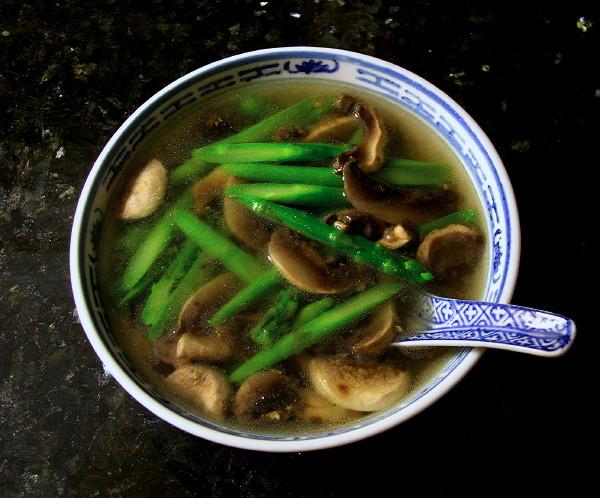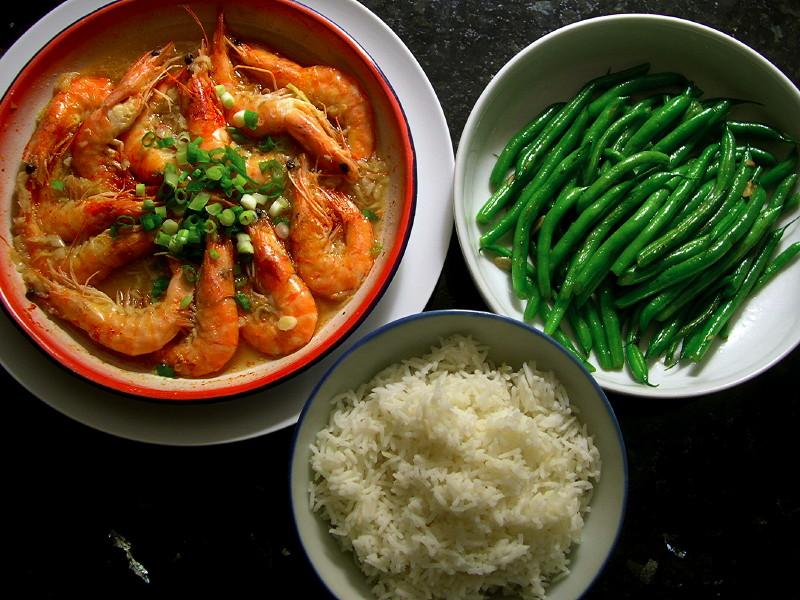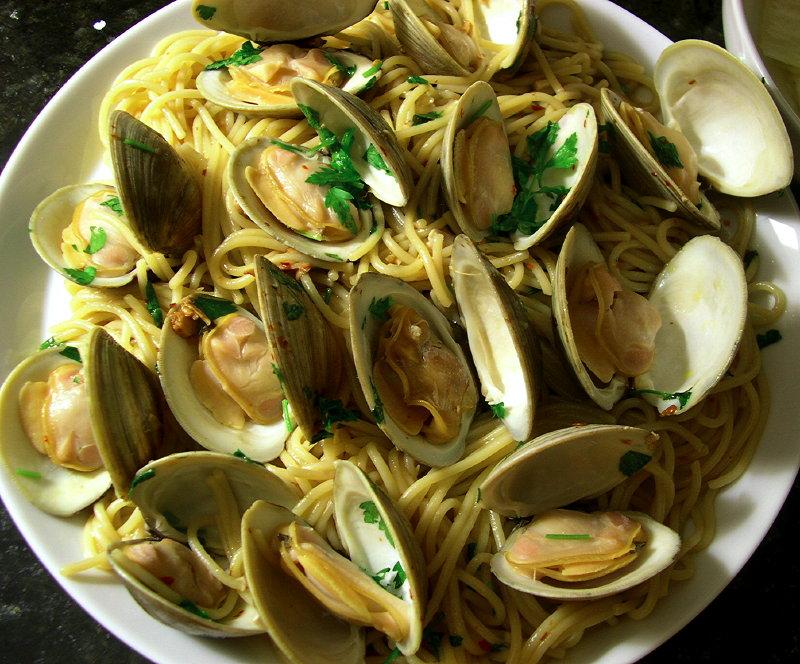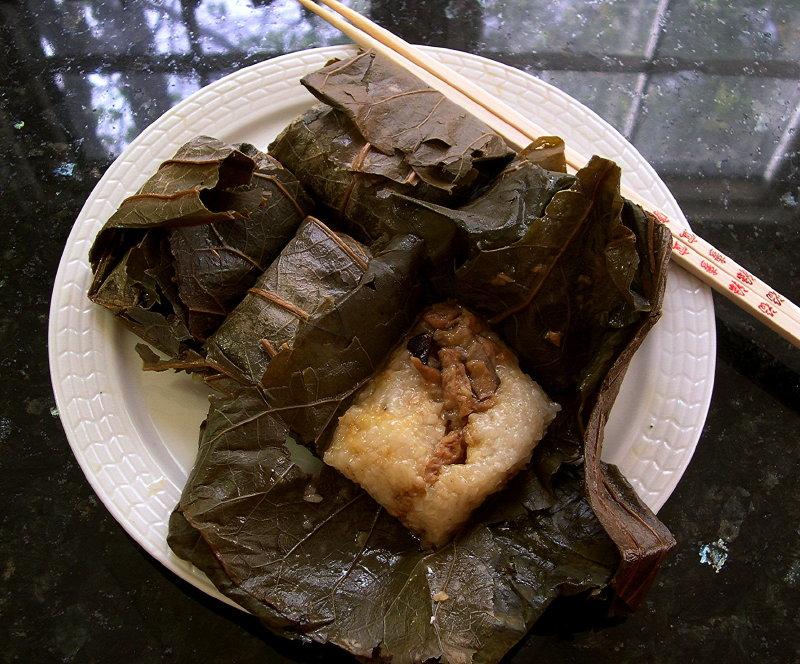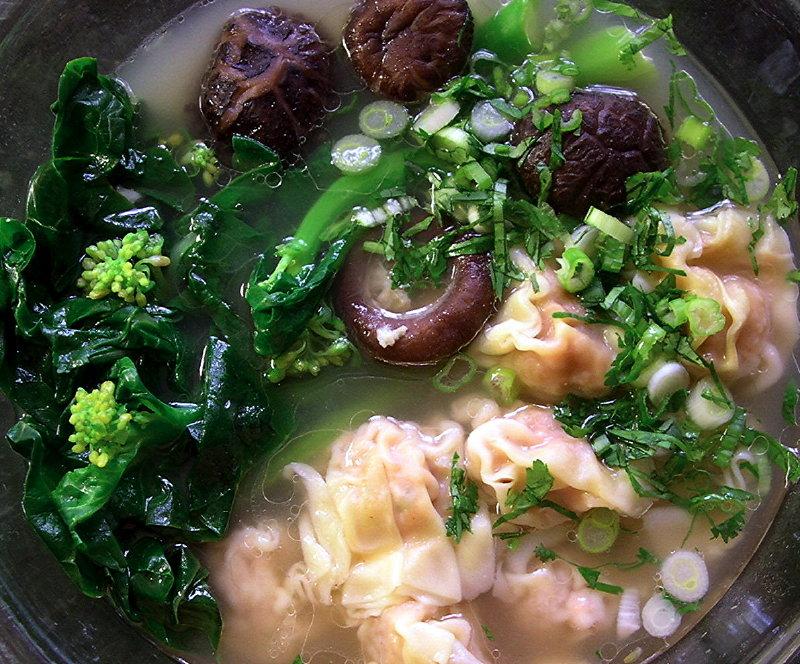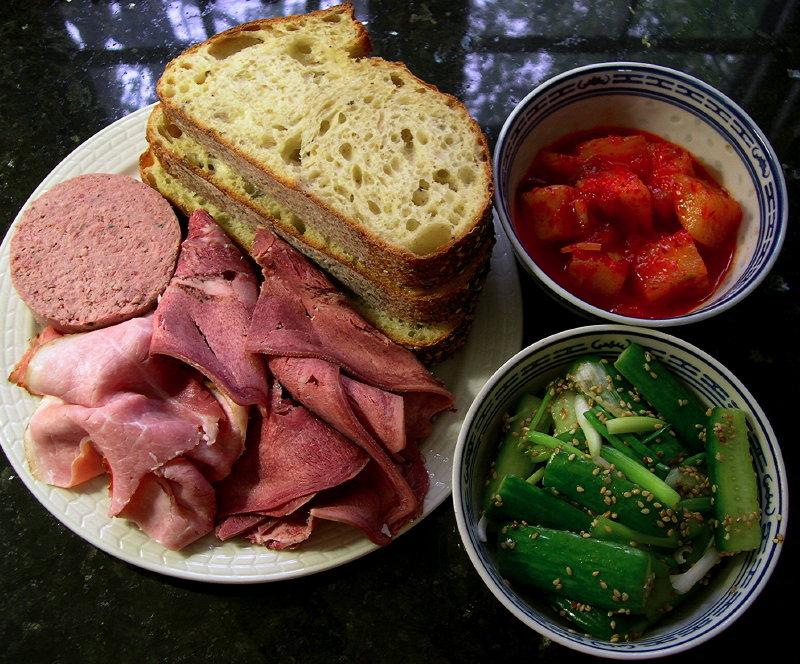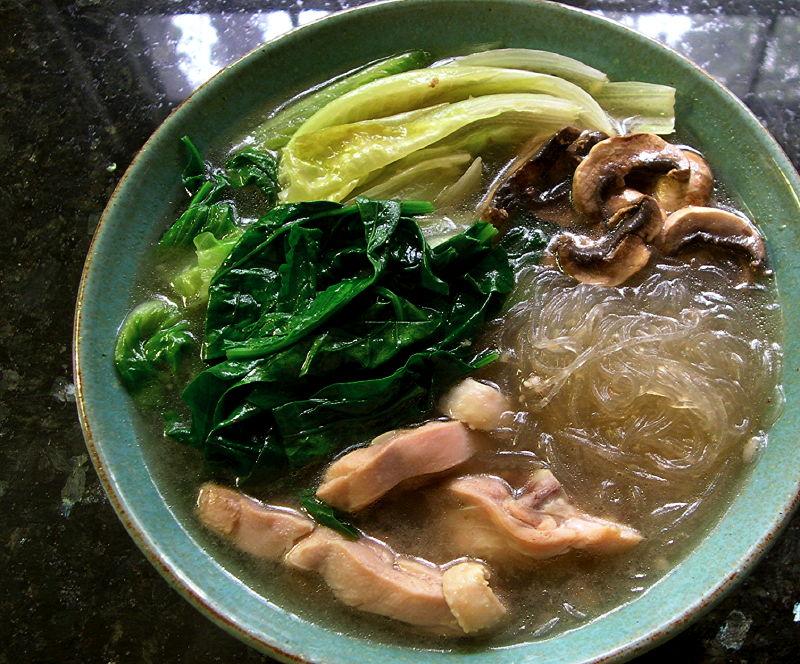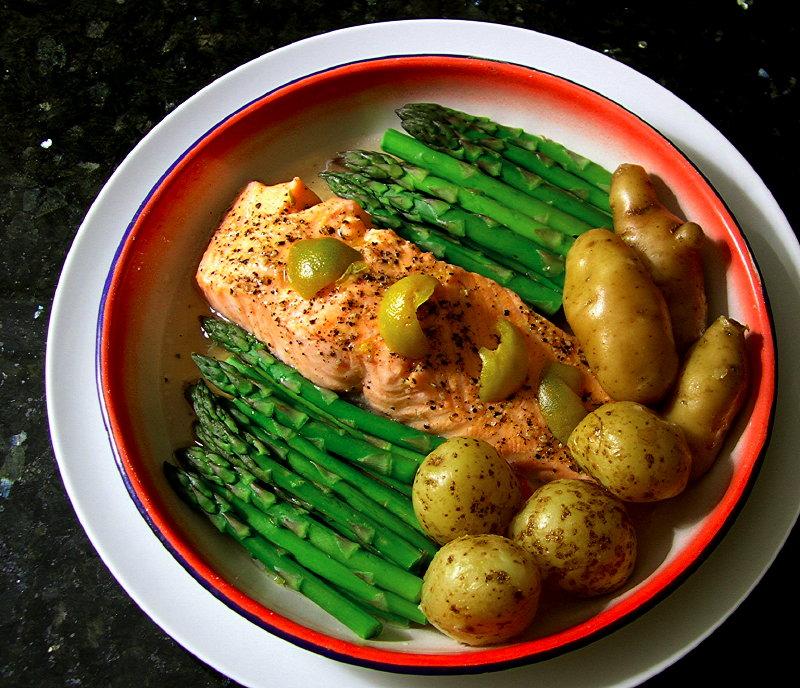-
Posts
3,810 -
Joined
-
Last visited
Content Type
Profiles
Forums
Store
Help Articles
Everything posted by huiray
-
Is there going to be a separate glossary section, where you list the foraged ingredients, specifics on them, botanical info, geographical range, etc; followed by uses for each ingredient with references to where in the book they were used; plus ingredients that resemble them or are substitutes for them, how they differ, where these substitutes would be found (geographical range) etc? This is distinct from a general index or a recipe index. Such a section would certainly bulk up the book and would be (to me anyway) one of the most useful sections in the kind of book you are intending to publish.
-
Turmeric functions as an acid-base indicator. Under basic conditions it turns red. Have you tried that? Also, red cabbage juice will have a range of colors depending on the pH.
-
• Soup. Asparagus & standard mushrooms in chicken stock w/ some oil. • Head-on shrimp, marinated in and steamed with Shaohsing wine, salt, corn oil, jozo mirin, ground white pepper, generous finely chopped smashed garlic & finely sliced ginger. • Green beans flash "stir-fried" w/ garlic. • White rice (Basmati).
- 587 replies
-
- 10
-

-
True enough. I certainly use animal fats for cooking/frying/stir-frying as occasion or desire arises, but for *routine* use I would go with one of the "liquid at room temperature" oils as largely discussed here. I've made many a dish using chicken fat, duck fat, (pig) lard, and so on...but no longer do so as a routine manner - for myself. Certainly in various cuisines or circumstances animal fats would be more of a routine oil for cooking. They were in older times too, of course. Some dishes cannot be made (or at least made correctly) if animal fats were not used. Confit, for one. KL Hokkien Mee, as another** - where pig lard is NECESSARY for the dish to be called "KL Hokkien Mee", and also certainly requires the addition of a generous amount of pork fat lardons into the dish at the end. ** which is one of the most delicious dishes in the world, IMO and that of many other folks, I am daring to say. :-) Oh, wok-hei needed, of course.
-
One of my favorite, FAVORITE soups when I was growing up was double-boiled pig's brain soup, done in the Cantonese/S-SE Chinese style, with selected herbs/root-rhizomes. This was eaten at restaurants, always - it was just too much trouble for my mother to make at home. I haven't had that for a long time; I bought frozen pig brains not that long ago (from the Chinese grocery) but never got round to preparing it - perhaps just as well as it probably would have fallen apart on defrosting and dissolved into the soup (especially after removing the membrane) which is NOT what properly prepared pig's brain soup should be like. (It should look like this, as one version) I asked around recently if I could get fresh pig brains from local butchers, local farmers, etc - and all of them turned me down.
-
But you're supposed to cut off the crusts and quarter them diagonally corner-to-corner into triangles!!!!
-
The manufacturers of the direct drive vacuum pumps I have dealt with do not recommend using automotive-grade oil, IIRC. One uses a special high-grade oil which is pale to light yellow in color and designated for use in vacuum pumps. I don't know what the freeze-dryer people will do but when I've ordered vacuum pumps before (and I've ordered quite a few) the pumps always shipped with a couple of jugs/bottles of oil sufficient to get you started (with a little left over). One simply buys the mist traps. They are not exactly 99¢ each, of course. :-) It is simple to "clamp" it to the pump exhaust, provided the requisite flanged port is on the pump. We are talking about a home environment, of course, so one can do whatever one wishes - but in a corporate/commercial scenario the safety inspectors often require (or strongly recommend) that mist traps be attached to vacuum pump exhausts. There is almost always a very fine, invisible "mist" of oil that is ejected from the pump - *especially* when the vacuum is first being established (evacuation of your freeze-dryer in the current case) which accumulates in the atmosphere of the immediate area and gets deposited on surfaces over time (or gets breathed in by you). Let alone visible blasting of oil particles from the exhaust into the air! P.s. If you overfill the pump with oil (above the max level) you WILL have quite visible ejection of oil from the exhaust port and even from the fill-port (if not already recapped) when you turn the pump on. :-) ;-) ETA: Actually, when we got lab-standard freeze-dryers (manifold type) I remember now we also got the oil shipped along with it.
-
Herb definition. Spice definition. Parsley is a herb. Cinnamon is a spice. As a more involved example, the dried rhizomes of angular Solomon's Seal (Polygonatum odoratum), called 玉竹 in Chinese cuisine and medicine, is considered a herb. I use it in things like herbal Bak Kut Teh and other soups, for example, where I would call it a herbal soup or soup with herbal ingredients. I might venture that most spices (but not all) in common usage would be dried. Most herbs (but not all¶) in common usage are best when fresh. (Exceptions abound, I imagine, as I mentioned below also) And so on. :-) ¶ See the Polygonatum odoratum example above. Most Chinese herbs of this sort (medicinal herbs) would also be dried in the commonly-available and commonly-used forms. Herbs whose leafy-parts are used I suppose are frequently better fresh. Herbs whose other parts like rhizomes, roots, are used are frequently dried. Exceptions abound, I expect, which also depend on the circumstances. The roots (as distinct from the leaves) of coriander (a herb), a vital ingredient in Thai cuisine (for example), is best used fresh - freezing them is OK but dried coriander roots I have not heard of. The leaf of Laurus nobilis is commonly thought of as a culinary herb but the plant would also fit the botanical definition of a spice; and some folks insist on using only the fresh leaves while others prefer the dried leaves, while for practical reasons the dried leaves may be the only option available to large swaths of the populace. :-)
-
Do we mean the vent or the exhaust? Mr Mike, I'm a little surprised to see that the vent (exhaust?) on the direct-drive pump you have (and picture) appears to be a single-unit thing attached straight to the body of the oil depository of the drive cabinet and then bent at 90º, assuming that is what you parked the plastic cup on. (And is not the handle for helping to lift/carry the pump). The exhausts on the direct-drive vacuum pumps I have come across in my experience (which is different from yours of course) were all ports with a coupled flange available (or convertible to one**) for attaching a mist trap... Many mist traps also have a little flow-back tube for the condensed oil from the trap to the bottom of the vent port for delivery back to the oil chamber of the pump. If the bleed/vent is meant, then I've never experienced oil blowing out of it - it just draws air into the pump chamber if not closed and the pump becomes very loud (and blows out much more oil through the exhaust :-) ) Hmm. **Rotary (belt-driven) vane vacuum pumps tended not to have the flanged exhaust but one could unscrew the fitting and replace that with a flanged one with the requisite coupling for a mist trap. Direct-drive pumps (in my experience) had the flanged coupling exhaust.
-
-
Lunch part 1: Glutinous rice w/ pork & shiitake mushrooms w/ savory seasoning; wrapped in lotus leaves. Steamed. [Commercial] Lunch part 2: Pork & shrimp wontons w/ XO sauce [Prime Food], w/ blanched kai-lan & small far-koo retrieved from the stock. Soup made w/ chicken stock + dried far-koo + dried small "stock fish" + smashed garlic + a little oil + simmer; filtered.
-
"Everything You Need to Know About Cooking with Blood". Um, not quite. Perhaps everything you need to know about cooking it in Western Europe and the USA, maybe, with Western cuisines. :-) The only sentence that mentions anything else is this one: "Yet from Scotland to Italy, Spain to Russia, and Tanzania to China, many traditional dishes still use blood." As for: "But sometime in recent history, we forgot how to use blood." Actually, the use of blood in many non-Western cuisines never went away. ;-) And also considering that Blutwurst & Zungenwurst etc are common in some parts of Europe and Haggis in others and blood pudding and blood sausages scattered here and there (and even as related in the article) that statement is a little bit of a hyperbole. :-)
-
But George has not seen any of the others actually cook anything yet. He only knows what he has seen of Gregory's skills at filleting mackerel, which was poor and that he had lied when he (Gregory) claimed that he was good at fish. You have now seen how the others cooked in the elimination challenge. He (George) never did. He may or may not have seen any of the others (including Gregory) in actual action in the kitchens of their respective restaurants and besides, doing things in the TC kitchen would be "new/alien" to any of them so how would one judge that one particular person could adapt immediately or not... Besides, he had every right to be angry at Gregory, who sort-of bullied/shamed him into doing the clams even after he (George) had *said* he was bad at shucking clams.
-
Thanks all. Wow, Mr Mike, you have some adventures with freezers!
-
Late lunch / early dinner. • Coarse Braunschweiger, pressed tongue, Westphalian ham. Semolina bread. • Kkakdugi. • Pickled mini-cucumbers & scallions, w/ toasted sesame seeds. Very satisfying.
-
I would like to ask a general question. How do you view these freeze-dried ingredients you make? Are they "preserved versions" (no more than that) of "fresh" ingredients? Are they just a form of "stuff you would eat" held for longer? Are they stuff that are "less fresh and less desirable than fresh" ingredients? Are they stuff that happily has more concentrated flavors in some cases but are still 'not the fresh stuff preferred'? Or are they separate ingredients in their own right? I ask because there is often a perception that "dried foodstuff" is a poor substitute for the fresh/real thing in Western cuisine, whereas many things in "Asian" cuisine (E/SE Asian in particular) value the dried ingredients as ingredients in their own right, whereby they have developed a certain characteristic that is irreproducible if one were to try using the fresh ingredient which would then, in fact, be a poor substitute for the dried ingredient. Taste, texture, etc. For that matter, in Western cuisine I can't imagine that bacon would be regarded as a poor substitute for fresh pork anymore. Ditto any number of salumi. But what about "freeze-dried substances"?? Yes, I note Mr Mike describing how he and his family members munch on freeze-dried stuff and like the concentrated flavor in some cases and the convenience in other cases. But what is the general perception of such things in regards to whether they are just a "not fresh" version o0f the real thing or as a separate thing in itself? I've described elsewhere how various things in the Chinese kitchen such as dried bok choy or salted plums or pickled mustard are all separate ingredients in their own right and CANNOT be substituted with the fresh equivalent. Or dried & salted cuttlefish or anchovies or fish. Etc etc etc. What about "freeze-dried ingredients" in a general sense? Or would you say that the two things (freeze-drying vs salting/preserving/pickling) are not comparable? If not, why not, in terms of "preservation"? (I'm fishing for statements for why the two are not comparable too, if that is the case, if that is how you view it)
-
Consider eating more in Chinese-Chinese restaurants, or getting siu-mei from Chinese charcuteries (especially Cantonese) where pig intestines from small to large to colons to bungs roasted/cooked in various ways are offered - plus all sorts of other roasted/smoked stuff. Offal in all its varied forms have been part of the Chinese menu for centuries. ;-) (Have you had fu qi fei pian, for that matter? :-) ) There is (was?) a video available on Youtube on Cosentino visiting a Chinese grocery where he exclaimed over all sorts of offal presented and sold matter-of-factly; and where he also asked the counter attendant (who happened to be Mexican, I think :-) ) about how to cook pig uterus. Cosentino's Incanto is now closed, alas.
-
Fri-Sat groceries. Om India Plaza: Basmati rice (Zebra), basmati rice (Tilda), cinnamon sticks (Indonesian), dried kokum (lowanala), yellow mustard seeds, black mustard seeds, fenugreek seeds, jaggery powder, small mottled-color round squash, white turmeric - fresh, curry leaves (karuveppillai), roasted vermicelli (dry goods, package), Punjabi-style potato samosas (frozen) [Mezban]. Saraga International Market: Shan Wai Shan High Mountain Oolong tea, beef short ribs, head-on shrimp, Top Neck clams, green onions (scallions), cilantro, mini-cucumbers (Persian), Chinese long beans. Broad Ripple Farmers' Market: Lion's Mane mushroom (1 head), celeriac, red turnips w/ greens, 3 sweet peppers, fennel bulb, large head of broccoli, green beans, Red Thumb fingerlings, tomatoes, large onions (2 red, 3 yellow), eggs. Claus' German Sausage & Meats: Pressed tongue, Westphalian ham, short-tied Knackwurst, coarse Braunschweiger. Amelia's Bakery/Bluebeard: Semolina bread.
-
"QQ Abalone and Chicken Soup Flavored Vermicelli" [sau Tao] (this one) added to chicken thighs (cut-up) simmered w/ garlic in water + oil + a little salt (with seasoning packs &etc as well); plus romaine heart, trimmed spinach, sliced standard button mushrooms.
-
Eater.com recap pf TCB ep1: http://www.eater.com/2014/10/16/6986929/top-chef-boston-episode-1-i-didnt-come-here-to-toss-salad
-
Here's a recap of TCB ep1 I enjoyed reading: http://www.baltimoresun.com/entertainment/bthesite/tv-lust/bal-top-chef-recap-sudden-death-20141016-story.html#page=1 Regarding the QF: That recap pointed out something I had not noticed in my first viewing of the episode; I just rewatched it and yes, George said that he sucked at shucking clams, said it publicly in front of the other (Red) team members and was trying to get Gregory to do it but was sort-of bullied into doing it by Gregory. Gregory boasted he was good at fish but that turned out to be incorrect - while George indeed proved that he was no good at clams, as he had *said* to the group. It sort of feels a bit - on rewatching - that he was thrown under the bus by Gregory (and/or the other members?) although we don't get to see/hear how they decided on who was going to do the lobsters and oysters. As for the Yellow team, Adam really did insist on his lobster prowess then blew it when actually doing it.
-
• Steamed salmon – dressed w/ salt, rice bran oil, hon mirin, black pepper, juice & rind of a ripening fresh calamansi lime before being steamed. • Asparagus, put in w/ the salmon halfway through steaming. • Baby potatoes & rose finn fingerlings simply boiled in salted water then tossed w/ butter.
-
The merguez sausages came from Smoking Goose via Goose the Market. (see here where I listed them) I took a couple of them, removed the casing and crumbled up the meat. Thanks for the comment on the photos, kind of you.
-
Yes, that shrimp was...uggh. Just ONE more ingredient? He said at judges' table that if he could he would have added LOTS MORE ingredients into it. His attitude reminds me of a former acquaintance of mine who boasted of a "curry powder" he made and marketed which had at last count (a few years ago) more than 20 ingredients and he stated that he would continue to add more and more things to it as he discovered them or thought of them...he sent me the list of things that went into it, saying it gave it a great complexity - but what it seemed like to me was that one would not be able to make out *anything* in it and rather than complexity it was just overwrought and ridiculously complicated (not complex) - which is what Richard Blais also said about the dish. If it were truly well made, like an excellent Oaxacan molé negro with 20++ ingredients in it, that would be a different matter - but here it seemed like a throwing together of everything but the kitchen sink. Oh it was soooo painful to see (and hear) his (Katsuji's) attempts at shucking clams. Salad strikes again!! :-) In a bad way, that is. On Top Chef anyway. I think it was Aaron (I need to check - later) who said, when questioned about the audacity of his making a pork belly dish in the short time they had, that he was there at TC to try to make interesting/challenging dishes (something like that), not to toss salad. :-) (BTW I am someone who does not like bacon in my salads) It was interesting to see the head-butting between George and Gregory and Gregory's flailing on his mackerel when he ostentatiously claimed he would (in effect) do expertly at it. George then mangled his clam-shucking anyway, oops. Maybe they should have exchanged duties? Richard Blais blogs about how George and Gregory were two excellent chefs, however, who produced very good dishes in that "sudden death cook-off" and how under other circumstances George would definitely have NOT gone home. As for Michael going home in the elimination challenge - I think I would agree with that decision. Nevertheless, both Katsuji (that complicated shrimp dish) and Katie (that salad) had narrow escapes. From just this first episode it seems to me that my hackles are rising up with Gegory and Adam, both with their "superior attitudes". And what's with Adam wrapping that US flag around his head as a do-rag? P.s. - from the preview of upcoming episodes, (SPOILER ALERT) Katsuji makes it fairly far into the competition...



